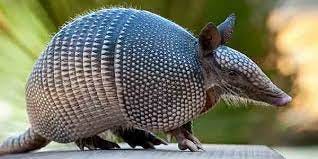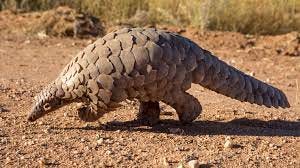So would you eat an armadillo?
Armadillos are native to the Americas; their closest relatives are sloths and anteaters. They are traditionally eaten in much of Central and South America, and they are especially prized in Oaxacan cuisine.
They sleep 16 hours a day, always have four babies at a time — and are considered terrible pests in parts of Texas because they tear up gardens and lawns while hunting for worms. You can find a few fun facts here.
How about a pangolin?
Pangolins might resemble armadillos, but they’re actually more closely related to dogs and cats, and their closest relative is the mongoose. These gentle creatures are the world’s most-trafficked animals (after humans). They are prized in Asia both for their meat and their scales which are thought to have medicinal qualities. Here is a link to an organization dedicated to saving the pangolin; after reading it Ruth is ashamed that she ever ate one.
But, while we have you, this is Ruth in Taishan, in the kitchen that prepared the pangolin.
And since we talk about the late, great, Cecilia Chiang, here’s a link to Soul of a Banquet, the extraordinary film director Wayne Wang made about the woman who introduced high-end Chinese cuisine to America.
A guinea pig perhaps?
Cuy is one of the staple foods of Peru. Here’s an article about it, but fair warning; the pictures are not for the faint of heart.
Laurie references the herb huacatay, a strong, aromatic member of the marigold family known as Peruvian black mint. She also mentions the article she wrote from Peru about the chef Virgilio Martinez, who leads the restaurant MIL and the research center Mater Projects in the Sacred Valley along with the Lima restaurant Central, which was ranked No. 1 on the World’s 50 Best Restaurants list. You can read the article here.
We discuss the classic book by Calvin Schwabe, Unmentionable Cuisine, a fine addition to any food-lover’s library. Irene Virbila wrote a wonderful article about it here.
How about lobster?
Before you answer that question, you might want to read the article David Foster Wallace wrote on the subject for Gourmet Magazine. You can find it here.
Geoducks anyone?
The first time she heard of the existence of clams that grow to 15 pounds Ruth was 18 years old, and she was convinced it was a hoax. From her Manhattan perspective it was impossible to think of an enormous clam as anything but a joke. The name made it seem even more absurd: Gooeyduck?
But geoducks are no joke. Native to the Pacific Northwest, they are among the stranger beasts of the world. And also among the most delicious. If you’ve ever had “giant clam” in a sushi bar, you’ve tasted geoduck. It is the essence of clam — briny, mild, crisp, crunchy.
For an adventurous cook, nothing would be cooler than to open up a package and find a giant clam. You can buy them here. Now what do you do? Slice that long neck into sushi and make the fat belly into an awesome chowder. If you want to know how to deal with this giant mollusk, here’s an instructional video from Andrew Zimmern.




























Share this post